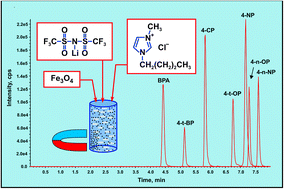Magnetic retrieval of ionic liquid formed during in situ metathesis dispersive liquid–liquid microextraction–preconcentration of selected endocrine disrupting phenols from an enlarged sample volume
Abstract
A new in situ dispersive liquid–liquid microextraction procedure with magnetic retrieval of ionic liquid was developed for the determination of selected endocrine disrupting phenols via quantification using HPLC with tandem mass spectrometry. Three different ionic liquids were tested but only 1-butyl-3-methylimidazolium bis(trifluoromethanesulfonyl)imide was found suitable for the analysis of bisphenol-A, 4-tert-butylphenol, 4-cumylphenol, 4-tert-octylphenol, 4-n-octylphenol, 4-n-nonylphenol and 4-nonylphenol (a mixture of branched nonylphenol isomers). The magnetic retrieval of the ionic liquid enabled to increase the sample volume and gain higher enrichment factors for the analyzed phenols. The optimized procedure utilizes 30 mL of a water sample, which is concentrated to about 150 μL. Sample preparation is simple and requires not more than 10 minutes. The detection limits obtained for this method are as follows: 24, 620, 4, 6, 14, 8 and 8 ng L−1 for bisphenol A, 4-tert-butylphenol, 4-cumylphenol, 4-tert-octylphenol, 4-nonylphenol, 4-n-octylphenol and 4-n-nonylphenol, respectively.


 Please wait while we load your content...
Please wait while we load your content...